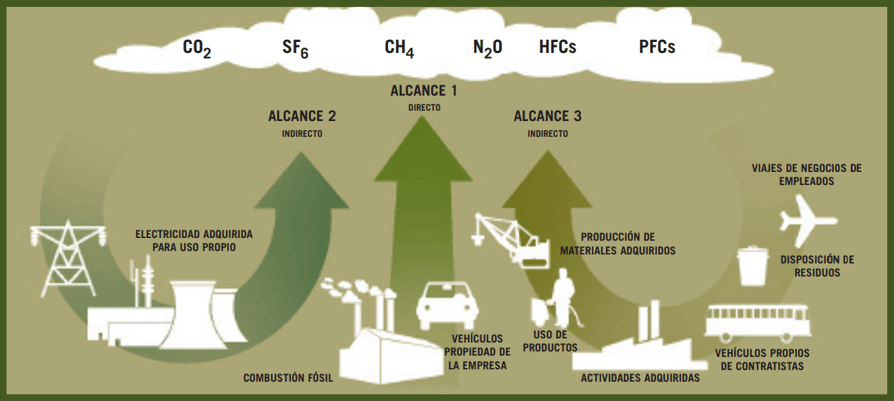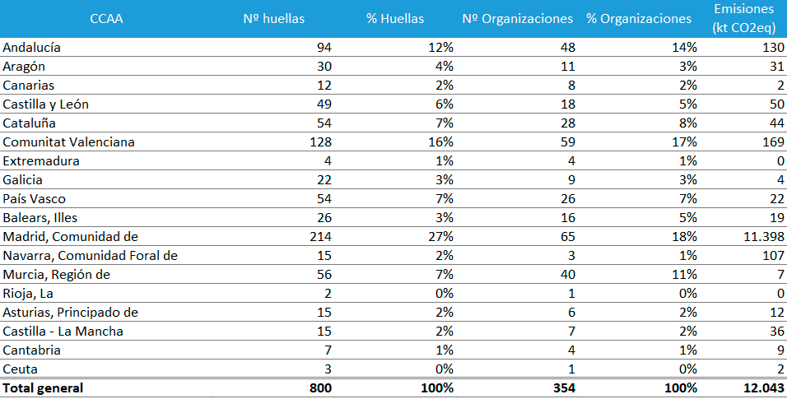In the context of the current climate crisis, it is necessary for companies and organizations to understand the environmental impact they generate and actively work to reduce it. To this end, the calculation of the carbon footprint is the essential tool for measuring and managing the greenhouse gas emissions of an organization or company.
Corporate carbon footprint
The corporate carbon footprint is the total amount of greenhouse gas emissions (GHG) that an organization or company emits directly or indirectly over a given period of time. The calculation method is very similar to the calculation of the carbon footprint of a product, which is carried out by means of life cycle analysis, but taking into account that what we are analysing is not a product but an organization; and that therefore the corporate carbon footprint covers all the emissions associated with the activities of a specific company or organization.
The measurement of a company's carbon footprint is essential to understand the origin and magnitude of the emissions it generates, allowing for the design of effective strategies to reduce them. That is, as long as we do not have objective data on our GHG emissions, we will not be able to define what changes to make to reduce them.
Calculating a company's carbon footprint has a number of advantages:
- Knowing the level of energy efficiency of the company and detecting opportunities to reduce costs through improvements in energy management.
- Improve the corporate image of the company, positioning it as a benchmark in the sector in terms of environmental responsibility and sustainability.
- Contribute to mitigating climate change and protecting the environment.

Scope of corporate carbon footprints
It is important to distinguish between direct and indirect GHG emissions in order to measure a company's carbon footprint. Direct emissions are those that come from sources that are owned or controlled by the organization. On the other hand, indirect emissions are those generated as a result of the organization's activities but occur in sources that are neither owned nor controlled by them.
For a more comprehensive measurement, three scopes are used to quantify a company's carbon footprint:
- Scope 1: direct GHG emissions of the company. For example, emissions from combustion in boilers, furnaces, vehicles, etc., that are owned or controlled by the entity in question.
- Scope 2: indirect GHG emissions associated with electricity generation purchased and consumed by the organization.
- Scope 3: all indirect GHG emissions occurring in the organization's value chain. Some examples of activities of this type of scope are the extraction and production of acquired materials, the transportation of acquired fuels, and the use of sold products and services.

Types of carbon footprint scopes of a company. Source: GHG Protocol
Scope 3 is the most complicated to quantify as it is outside the control of the reporting company, although it can represent the majority of its GHG emissions inventory. Examples of some emission sources that can be analysed to determine this scope are employee commutes to their workplace, business trips, paper, water, and toner consumption, waste, and goods and services acquired.
It is important to measure the three scopes comprehensively to have a global view of the company's carbon footprint and, in this way, to be able to set reduction targets and apply more effective measures.
How is a company's carbon footprint measured?
More and more companies recognize the importance of measuring their corporate carbon footprint and adopting concrete measures to reduce their environmental impact. This approach has become especially relevant due to the increasing environmental regulations and consumer demand for sustainable practices. For example, Ecoalf, a leading brand in sustainable clothing, has decided to go one step further and aims to be a carbon-neutral company by 2030.
The carbon footprint resulting from each emission source is calculated by multiplying the consumption data (activity data) by the corresponding emission factor:
Carbon footprint = Activity Data x Emission Factor
The activity data represents the level of activity that generates greenhouse gas emissions, such as the amount of natural gas used for heating (kWh of natural gas).
The emission factor indicates the amount of greenhouse gases emitted per unit of activity data. For example, in the case of natural gas, the emission factor would be 0.202 kg CO2 eq/kWh of natural gas.
MITECO sets out a series of steps to be followed in order to calculate the corporate carbon footprint:
- Define the time period to be measured (usually calculated in a calendar year).
- Establish organizational and operational boundaries, determining the areas included in information collection and calculations, and identifying the emitting sources related to operations in those areas.
- Collect the consumption data (activity data) of these operations.
- Implement a data collection system to facilitate the task in subsequent years.
- Perform the corresponding calculations by multiplying the activity data by the emission factors, using calculation methods and reference guides for calculating the carbon footprint, such as the GHG Protocol or the MITECO guide, which are discussed below.
- Prepare a carbon footprint report that summarizes the calculations made and contains a plan to reduce GHG emissions.
- Finally, we will be able to opt for certifying the corporate carbon footprint through an independent third party, who will corroborate the calculations and detect possible errors.
Calculating the corporate carbon footprint from scratch can be a difficult process, so there are tools and methodologies to help us in this process:
GHG Protocol
The GHG Protocol is the most widely recognized and internationally used methodology for identifying, calculating, reporting and managing a company's GHG emissions. Additionally, the protocol provides guidance on how to conduct a company's GHG emissions inventory, as well as on the preparation of a carbon footprint report.
The guide "Guidance on how to measure and report your greenhouse gas emissions"is another useful tool for measuring a company's carbon footprint. It is developed by DEFRA (UK Department for Environment, Food and Rural Affairs) and provides a detailed methodology for measuring and reporting a company's GHG emissions, following the GHG Protocol approach.
Carbon Footprint Registry (MITECO)
In Spain, the MITECO (Ministry for Ecological Transition and Demographic Challenge) comprises the Carbon Footprint Register, which lists companies working on their carbon footprint. The registry offers the seals 'Calculate', 'Calculate and reduce', 'Calculate and offset', and 'Calculate, reduce and offset' depending on the action related to the carbon footprint taken by the company. The list of companies belonging to the register is available on its website.

Carbon Footprint Registry Stamps. Source: MITECO
The building industry is the sector that has second highest number of carbon footprints calculated and with the most organizations registered on the registry, behind the manufacturing industry. Between 2009 and 2022, 354 organizations and companies in the sector have registered, calculating a total of 800 carbon footprints. Even so, only 86 of these have been calculated taking into account scopes 1, 2, and 3. Since 2008, the building industry has registered a total value of 12,043 kilotonnes of CO2 emissions, with the Community of Madrid being the autonomous community with the highest emissions during this time.

Carbon footprints of the building industry registered in the MITECO (2008-2021)
MITECO has also developed the "Guide for calculating an organization's carbon footprint and developing an improvement plan", based on the GHG Protocol. It also offers tools to facilitate the calculation of the carbon footprint, such as the CO₂ Emissions Calculator of the Spanish Climate Change Office.
In conclusion, measuring the corporate carbon footprint is essential for companies to become aware of their environmental impact and implement measures to reduce it. This not only helps protect the environment, but it can also enhance the reputation and value of the brand by demonstrating a commitment to sustainability.


